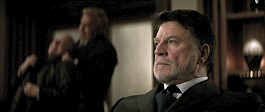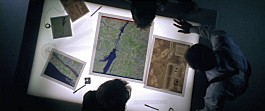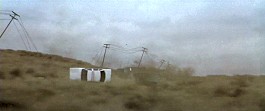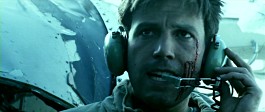 The Sum of All Fears appears in an aspect ratio of approximately 2.35:1 on this single-sided, dual-layered DVD; the image has been enhanced for 16X9 televisions. While most of Fears looked excellent, a few small issues knocked down my grade to “B” territory.
The Sum of All Fears appears in an aspect ratio of approximately 2.35:1 on this single-sided, dual-layered DVD; the image has been enhanced for 16X9 televisions. While most of Fears looked excellent, a few small issues knocked down my grade to “B” territory.
Sharpness appeared terrific. At all times, the movie remained nicely distinct and detailed. Softness caused no concerns, and the picture seemed well defined and accurate. I noticed no problems related to moiré effects or jagged edges, but a small amount of edge enhancement manifested itself. As for print flaws, some light grain appeared at times, and I also saw a few small bits of grit.
Colors varied due to the production design. During the film’s first half, they took on a natural and warm tint for the most part, and they seemed distinct and vivid. Red lighting looked a bit heavy, but otherwise the hues worked well. For story reasons, the movie used a much more stark palette during its second half. The image became very desaturated, which meant that colors largely played only a small role in that part of the film. They continued to display appropriate tones, however.
As for the rest of the picture, the story seemed simpler. Black levels consistently came across as deep and rich, while shadow detail appeared dark but not too thick. Overall, The Sum of All Fears presented a solid image, but not one that earned any special honors.
 Although also not a reference piece of work, the Dolby Digital 5.1 soundtrack of The Sum of All Fears offered a stronger presentation. Actually, like the color saturation of the film, the soundfield also changed as the movie progressed. During its first half, the audio demonstrated a surprisingly strong emphasis on the front speakers. Even during scenes that lend themselves to surround usage – such as rainstorms – the sound stayed pretty well established in the forward realm.
Although also not a reference piece of work, the Dolby Digital 5.1 soundtrack of The Sum of All Fears offered a stronger presentation. Actually, like the color saturation of the film, the soundfield also changed as the movie progressed. During its first half, the audio demonstrated a surprisingly strong emphasis on the front speakers. Even during scenes that lend themselves to surround usage – such as rainstorms – the sound stayed pretty well established in the forward realm.
This changed midway through the movie, and the soundfield definitely opened up at that time. From the football game on, the track displayed a lively presence, as helicopters, other vehicles, and a mix of different elements added greater activity to the piece. The film’s second half provided the kind of punchy soundfield I expected from this sort of flick.
Audio quality appeared consistently excellent. Speech remained natural and warm, with no issues related to edginess or intelligibility. Music sounded clean and distinct, and the score also boasted nice range and punch. Effects provided the track’s most prominent elements, especially during the more active second half of the movie. They always appeared clear and accurate, and the louder elements came across as deep and powerful. The movie featured solid bass response across the board. For the first half of Fears, I planned to give it a “B+” for audio, but the second segment boosted that grade to an “A-“.
Paramount’s release of The Sum of All Fears includes a mix of extras, and we begin with two separate audio commentaries. The first comes from director Phil Alden Robinson and director of photography John Lindley, both of whom sat together from this running, screen-specific piece. The track emphasizes technical elements, which makes it somewhat dry at times. Actually, the program starts slowly, and the discussion during the film’s first act comes across as fairly dull; we learn about sets, locations, and lighting but not much else.
 Matters pick up after a while, though. While the commentary never becomes terribly lively, Robinson and Lindley provide more interesting material as they move through the film. They get into some of the elements that caused them problems and also relate a few storytelling challenges. The details still tend toward the technical side, but the presentation seems more engaging. Occasional empty spots appear but these don’t overwhelm the presentation. Overall, the first commentary is a fairly average affair.
Matters pick up after a while, though. While the commentary never becomes terribly lively, Robinson and Lindley provide more interesting material as they move through the film. They get into some of the elements that caused them problems and also relate a few storytelling challenges. The details still tend toward the technical side, but the presentation seems more engaging. Occasional empty spots appear but these don’t overwhelm the presentation. Overall, the first commentary is a fairly average affair.
Next we get a track that features Robinson with author Tom Clancy, both of whom also were recorded together for this running, screen-specific track. A lot of commentaries sound good on paper but end up being dull, and I worried that might happen here. Happily, that didn’t occur. While not an outstanding piece, this track provides a good listen.
Robinson occasionally covers ground that he discussed in the other commentary, but mostly he gives us unique information, and the presence of Clancy enlivens matters. The author seems refreshingly blunt, and he often tells us what aspects of the movie seem unrealistic. For his part, Robinson reveals why the filmmakers occasionally compromised those elements, and also asks Clancy for his take on different parts. As with the first commentary, this one suffers from a few too many empty spots, and I would have liked to learn more about differences between the book and the movie; Clancy hints that the two share little in common, but since I never read the movie, I’d like more details. Nonetheless, this track offers a brisk and entertaining affair.
 After this we move to some featurettes. A Cautionary Tale splits into two areas. “Casting” lasts 12 minutes and 56 seconds and mixes behind the scenes shots, movie clips, and interviews with director Phil Alden Robinson, screenwriter Daniel Pyne, producer Mace Neufeld, and actors Ben Affleck, Live Schreiber, Bridget Moynahan, James Cromwell, Morgan Freeman Ciaran Hinds and Alan Bates. We get some basic notes about how the actors came to the film and also their work on the set, but the piece also includes a lot of basic praise about everybody. The program includes a modicum of useful material but it seems too fluffy.
After this we move to some featurettes. A Cautionary Tale splits into two areas. “Casting” lasts 12 minutes and 56 seconds and mixes behind the scenes shots, movie clips, and interviews with director Phil Alden Robinson, screenwriter Daniel Pyne, producer Mace Neufeld, and actors Ben Affleck, Live Schreiber, Bridget Moynahan, James Cromwell, Morgan Freeman Ciaran Hinds and Alan Bates. We get some basic notes about how the actors came to the film and also their work on the set, but the piece also includes a lot of basic praise about everybody. The program includes a modicum of useful material but it seems too fluffy.
“Production” runs 17 minutes and follows the same framework as “Casting”. It includes interviews with producer Mace Neufeld, director Phil Alden Robinson, cinematographer John Lindley, screenwriter Daniel Pyne, actors Morgan Freeman, Ben Affleck, Alan Bates, Bridget Moynahan, James Cromwell and Liev Schreiber, and CIA public affairs officer Chase Brandon. “Production” packs a lot of good information into its brief running time. It covers the adaptation of the novel, the reworking of the franchise to accommodate Affleck’s age, reactions to the film in the post-September 11 world, and a number of production anecdotes. Overall, it goes through a lot of topics in a quick and interesting manner.
Visual Effects breaks into five subdomains, each of which examines a specific element of the movie. We learn about “Carrier Attack” (eight minutes, 40 seconds), “A-4” (6:25), “Hospital” (3:55), “Motorcade” (3:58), and “Helicopter” (4:53). The presentation includes production materials and behind the scenes shots, movie clips, and interviews with visual effects supervisor Glenn Neufeld, miniature modelmaker Carlyle Livingston II, miniature pyrotechnics John Cazin, cinematographer John Lindley, aerial coordinator Craig Hosking, CG supervisor Mike O’Neal, and visual effects supervisor Derek Spears. Though some of the material seems a little dry, for the most part the presentation enlivens the topic and makes these featurettes nicely engaging. As a nice touch, each segment ends with the completed footage for the scene just discussed. The behind the scenes work meshes well with the interviews to make this an informative and compelling series of pieces.
 Finally, we get the film’s theatrical trailer, presented non-anamorphic 1.85:1 with Dolby Digital 5.1 audio. As usual with Paramount’s releases, most of the extras provide both English and French subtitles.
Finally, we get the film’s theatrical trailer, presented non-anamorphic 1.85:1 with Dolby Digital 5.1 audio. As usual with Paramount’s releases, most of the extras provide both English and French subtitles.
While I don’t think The Sum of All Fears does much that seems particularly original or compelling, it offers a reasonably involving action flick that works acceptably well as a whole. Nothing in it stands out as terribly memorable, but it creates a fairly exciting piece that I enjoyed for the most part. The DVD provides generally positive picture along with very good audio and a solid roster of extras. My feelings toward Fears remain too lackluster for it to earn a strong recommendation, but the combination of pretty good movie along with a nice DVD put it into the “give it a look” bin.



